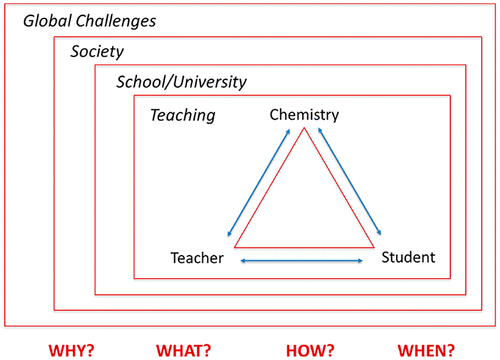当前位置:
X-MOL 学术
›
J. Chem. Educ.
›
论文详情
Our official English website, www.x-mol.net, welcomes your
feedback! (Note: you will need to create a separate account there.)
Didaktik Models in Chemistry Education.
Journal of Chemical Education ( IF 2.5 ) Pub Date : 2020-03-26 , DOI: 10.1021/acs.jchemed.9b01034 Jesper Sjöström 1 , Ingo Eilks 2 , Vicente Talanquer 3
Journal of Chemical Education ( IF 2.5 ) Pub Date : 2020-03-26 , DOI: 10.1021/acs.jchemed.9b01034 Jesper Sjöström 1 , Ingo Eilks 2 , Vicente Talanquer 3
Affiliation

|
The decisions and actions that chemistry educators make regarding why, what, how, and when to teach certain content or implement a specific instructional activity are often guided, but also constrained, by explicit or implicit “didaktik models”. These types of models direct our attention and actions when designing curricula, planning for instruction, or assessing the learning process. They also give educators a professional language when talking or reflecting about teaching and learning. When used systematically, didaktik models support the implementation of research-based instructional practices and are helpful in the professional development of educators. In this essay, we describe, analyze, and discuss the nature and utility of didaktik models in chemistry education and argue that it is critical for chemistry educators to recognize and reflect on the types of models that guide their work.
中文翻译:

化学教育中的Didaktik模型。
化学教育工作者关于为什么,什么,如何以及何时教某些内容或实施特定指导活动的决定和行动通常受到显性或隐性“ didaktik模型”的指导,但也受到约束。在设计课程,计划教学或评估学习过程时,这些类型的模型可引导我们的注意力和行动。在谈论或反思教与学时,它们还为教育工作者提供了专业的语言。当系统地使用Didaktik模型时,它们可以支持基于研究的教学实践的实施,并有助于教育工作者的专业发展。在本文中,我们描述,分析,
更新日期:2020-04-24
中文翻译:

化学教育中的Didaktik模型。
化学教育工作者关于为什么,什么,如何以及何时教某些内容或实施特定指导活动的决定和行动通常受到显性或隐性“ didaktik模型”的指导,但也受到约束。在设计课程,计划教学或评估学习过程时,这些类型的模型可引导我们的注意力和行动。在谈论或反思教与学时,它们还为教育工作者提供了专业的语言。当系统地使用Didaktik模型时,它们可以支持基于研究的教学实践的实施,并有助于教育工作者的专业发展。在本文中,我们描述,分析,











































 京公网安备 11010802027423号
京公网安备 11010802027423号